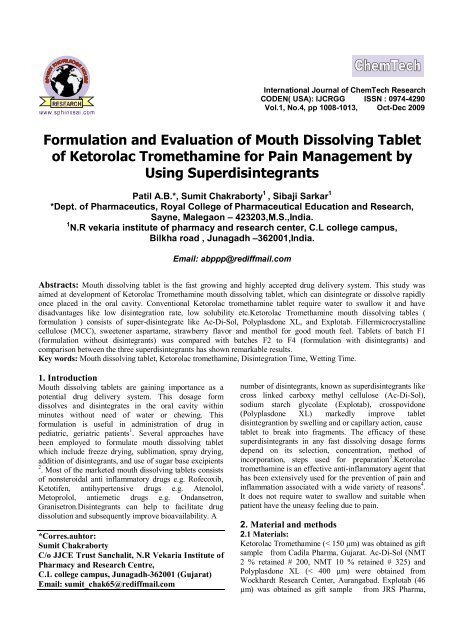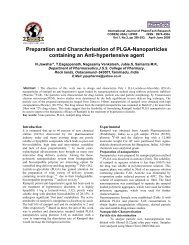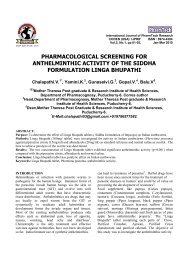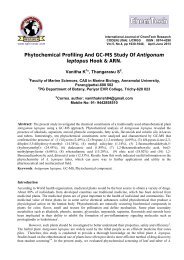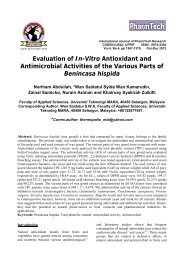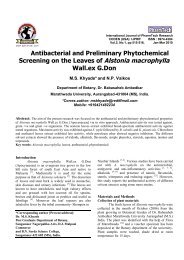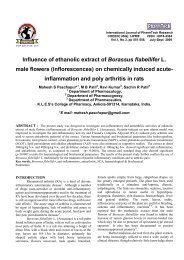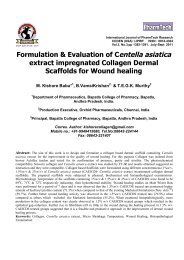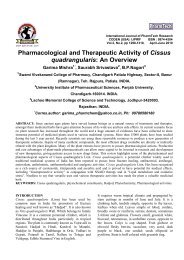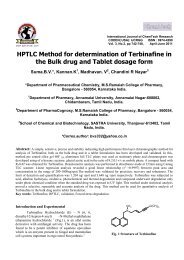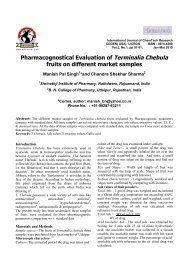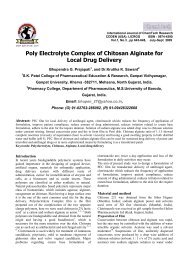Formulation and Evaluation of Mouth Dissolving Tablet - Research ...
Formulation and Evaluation of Mouth Dissolving Tablet - Research ...
Formulation and Evaluation of Mouth Dissolving Tablet - Research ...
Create successful ePaper yourself
Turn your PDF publications into a flip-book with our unique Google optimized e-Paper software.
International Journal <strong>of</strong> ChemTech <strong>Research</strong><br />
CODEN( USA): IJCRGG ISSN : 0974-4290<br />
Vol.1, No.4, pp 1008-1013, Oct-Dec 2009<br />
<strong>Formulation</strong> <strong>and</strong> <strong>Evaluation</strong> <strong>of</strong> <strong>Mouth</strong> <strong>Dissolving</strong> <strong>Tablet</strong><br />
<strong>of</strong> Ketorolac Tromethamine for Pain Management by<br />
Using Superdisintegrants<br />
Patil A.B.*, Sumit Chakraborty 1 , Sibaji Sarkar 1<br />
*Dept. <strong>of</strong> Pharmaceutics, Royal College <strong>of</strong> Pharmaceutical Education <strong>and</strong> <strong>Research</strong>,<br />
Sayne, Malegaon – 423203,M.S.,India.<br />
1 N.R vekaria institute <strong>of</strong> pharmacy <strong>and</strong> research center, C.L college campus,<br />
Bilkha road , Junagadh –362001,India.<br />
Email: abppp@rediffmail.com<br />
Abstracts: <strong>Mouth</strong> dissolving tablet is the fast growing <strong>and</strong> highly accepted drug delivery system. This study was<br />
aimed at development <strong>of</strong> Ketorolac Tromethamine mouth dissolving tablet, which can disintegrate or dissolve rapidly<br />
once placed in the oral cavity. Conventional Ketorolac tromethamine tablet require water to swallow it <strong>and</strong> have<br />
disadvantages like low disintegration rate, low solubility etc.Ketorolac Tromethamine mouth dissolving tables (<br />
formulation ) consists <strong>of</strong> super-disintegrate like Ac-Di-Sol, Polyplasdone XL, <strong>and</strong> Explotab. Fillermicrocrystalline<br />
cellulose (MCC), sweetener aspartame, strawberry flavor <strong>and</strong> menthol for good mouth feel. <strong>Tablet</strong>s <strong>of</strong> batch F1<br />
(formulation without disintegrants) was compared with batches F2 to F4 (formulation with disintegrants) <strong>and</strong><br />
comparison between the three superdisintegrants has shown remarkable results.<br />
Key words: <strong>Mouth</strong> dissolving tablet, Ketorolac tromethamine, Disintegration Time, Wetting Time.<br />
1. Introduction<br />
<strong>Mouth</strong> dissolving tablets are gaining importance as a<br />
potential drug delivery system. This dosage form<br />
dissolves <strong>and</strong> disintegrates in the oral cavity within<br />
minutes without need <strong>of</strong> water or chewing. This<br />
formulation is useful in administration <strong>of</strong> drug in<br />
pediatric, geriatric patients 1 . Several approaches have<br />
been employed to formulate mouth dissolving tablet<br />
which include freeze drying, sublimation, spray drying,<br />
addition <strong>of</strong> disintegrants, <strong>and</strong> use <strong>of</strong> sugar base excipients<br />
2 . Most <strong>of</strong> the marketed mouth dissolving tablets consists<br />
<strong>of</strong> nonsteroidal anti inflammatory drugs e.g. R<strong>of</strong>ecoxib,<br />
Ketotifen, antihypertensive drugs e.g. Atenolol,<br />
Metoprolol, antiemetic drugs e.g. Ondansetron,<br />
Granisetron.Disintegrants can help to facilitate drug<br />
dissolution <strong>and</strong> subsequently improve bioavailability. A<br />
*Corres.auhtor:<br />
Sumit Chakraborty<br />
C/o JJCE Trust Sanchalit, N.R Vekaria Institute <strong>of</strong><br />
Pharmacy <strong>and</strong> <strong>Research</strong> Centre,<br />
C.L college campus, Junagadh-362001 (Gujarat)<br />
Email: sumit_chak65@rediffmail.com<br />
number <strong>of</strong> disintegrants, known as superdisintegrants like<br />
cross linked carboxy methyl cellulose (Ac-Di-Sol),<br />
sodium starch glycolate (Explotab), crosspovidone<br />
(Polyplasdone XL) markedly improve tablet<br />
disintegrantion by swelling <strong>and</strong> or capillary action, cause<br />
tablet to break into fragments. The efficacy <strong>of</strong> these<br />
superdisintegrants in any fast dissolving dosage forms<br />
depend on its selection, concentration, method <strong>of</strong><br />
incorporation, steps used for preparation 3 .Ketorolac<br />
tromethamine is an effective anti-inflammatory agent that<br />
has been extensively used for the prevention <strong>of</strong> pain <strong>and</strong><br />
inflammation associated with a wide variety <strong>of</strong> reasons 4 .<br />
It does not require water to swallow <strong>and</strong> suitable when<br />
patient have the uneasy feeling due to pain.<br />
2. Material <strong>and</strong> methods<br />
2.1 Materials:<br />
Ketorolac Tromethamine (< 150 µm) was obtained as gift<br />
sample from Cadila Pharma, Gujarat. Ac-Di-Sol (NMT<br />
2 % retained # 200, NMT 10 % retained # 325) <strong>and</strong><br />
Polyplasdone XL (< 400 µm) were obtained from<br />
Wockhardt <strong>Research</strong> Center, Aurangabad. Explotab (46<br />
µm) was obtained as gift sample from JRS Pharma,
Patil A.B. et al /Int.J. ChemTech Res.2009,1(4) 1009<br />
USA, Magnesium Stearate <strong>and</strong> Colloidal silicon dioxide<br />
were obtained from S.D. Fine Chemicals, Mumbai.<br />
2.2 Methods:<br />
Characterization <strong>of</strong> Disintegrate Powder:<br />
Angle <strong>of</strong> Repose:<br />
The angle <strong>of</strong> repose 5 was determined by the funnel<br />
method. The accurately weighed powder was taken in a<br />
funnel. The height <strong>of</strong> a funnel was adjusted in such a way<br />
that its tip just touches the apex <strong>of</strong> the heap <strong>of</strong> the<br />
powder. The powder was allowed to flow through funnel<br />
freely onto the surface. The diameter <strong>of</strong> the powder heap<br />
was measured <strong>and</strong> angle <strong>of</strong> repose was calculated using<br />
following equation:<br />
tan (θ) = h/r<br />
Where h <strong>and</strong> r indicate the height <strong>and</strong> radius <strong>of</strong> the<br />
powder heap.<br />
Moisture sorption study:<br />
Moisture sorption study 5 was performed using<br />
Programmable environmental test chamber (Remi labs,<br />
Mumbai).<br />
One gram <strong>of</strong> disintegrant was taken in a petridish <strong>and</strong><br />
spread uniformly. Then it was kept in programmable<br />
environmental test chamber at 37 ± 1 0 C <strong>and</strong> 75% <strong>and</strong><br />
85% relative humidity for two days. Then calculated<br />
moisture sorption by recording weight difference <strong>of</strong> the<br />
sample before <strong>and</strong> after exposure to programmable<br />
environmental test chamber.<br />
Swelling capacity:<br />
Disintegrant (1g) was taken in the measuring cylinder.<br />
Then distilled water (10 ml) was poured in it. The<br />
measuring cylinder was shacked vigorously for 10<br />
minutes <strong>and</strong> allowed to st<strong>and</strong> for 24 hrs at 37 ± 1 0 C.<br />
Swelling capacity 5 was expressed as percentage <strong>and</strong><br />
calculated using following equation,<br />
Swelling capacity = (Xv/Xi) 100<br />
Where Xv: Final volume occupied by swollen material<br />
after 24 hrs.<br />
Xi: Initial volume occupied by powder in<br />
measuring cylinder.<br />
Hydration Capacity (H. C.):<br />
Disintegrant (1g) was taken in the 15 ml tarred<br />
centrifuge tube. Then 10 ml <strong>of</strong> distilled water was added<br />
to it <strong>and</strong> allowed to centrifuge for 10 minutes. After the<br />
centrifugation process the tarred centrifuge tube was<br />
taken out <strong>and</strong> inverted to remove the supernent. The<br />
decanted tube then weighed on digital balance<br />
(Shimadzu) <strong>and</strong> the hydration capacity 5 was calculated<br />
using following equation,<br />
H. C. = weight <strong>of</strong> hydrate sample/ weight <strong>of</strong> dry<br />
sample<br />
Density:<br />
The loose bulk density (LBD) 6 <strong>and</strong> tapped bulk density<br />
(TBD) <strong>of</strong> disintegrant were determined. Disintegrant (2g)<br />
was poured into calibrated measuring cylinder (10 ml)<br />
then noted initial volume. Then the cylinder was allowed<br />
to fall under its own weight onto the hard surface from<br />
the height <strong>of</strong> 2.5 cm at 2 seconds intervals. The tapping<br />
was the continued no further change in volume was<br />
noted. LBD <strong>and</strong> TBD were calculated using following<br />
equation,<br />
LBD = weight <strong>of</strong> the powder / volume <strong>of</strong> the packing<br />
TBD = weight <strong>of</strong> the powder / tapped volume <strong>of</strong> the<br />
packing<br />
Compressibility:<br />
The compressibility index (Carr’s Index)<br />
determined by using following equation,<br />
Carr’s Index (%) = [(TBD- LBD) × 100] / TBD<br />
6 was<br />
2.3 Preparation <strong>of</strong> tablets:<br />
Ketorolac tromethamine, microcrystalline carboxymethyl<br />
cellulose (MCC) <strong>and</strong> Aspartame were mixed with<br />
disintegrant for 15 minutes in porcelain mortar then<br />
passed through sieve # 60. This blend then mixed with<br />
Strawberry flavour, Menthol, colloidal silicon dioxide<br />
<strong>and</strong> magnesium stearate for 5 minutes. Then directly<br />
compressed by using 7 mm round flat faced punch <strong>of</strong><br />
rotary tablet machine (Karnavati, India). Compressed<br />
force was kept constant for all formulations. The<br />
magnesium stearate level was fixed at 1% w/w for all<br />
formulation. Disintegrants were used at 4% w/w in<br />
tablets.<br />
2.4 <strong>Evaluation</strong> <strong>of</strong> tablet characteristics:<br />
Weight Variation, Drug Content, Friability, Hardness<br />
<strong>and</strong> Thickness:<br />
<strong>Tablet</strong> weight variation, thickness, <strong>and</strong> friability were<br />
measured using the USP methods <strong>and</strong> criteria. Drug<br />
content was analyzed using a UV spectrophotometer<br />
(Shimadzu, UV-1700) at λmax 322 nm in methanol <strong>and</strong><br />
tablet friability was measured using the friability tester<br />
(Roche friabilator). Thickness was measured using the<br />
vernier caliper. Hardness was measured using the<br />
Monsanto hardness tester. Weight, drug content, hardness<br />
<strong>and</strong> thickness <strong>of</strong> tablets were represented as mean ± SD.<br />
Disintegration test:<br />
R<strong>and</strong>omly six tablets were selected from each batch for<br />
disintegration test. Disintegration test was performed<br />
without disc in distilled water using USP disintegration<br />
apparatus. The mean ± SD <strong>of</strong> 6 tablets were calculated.<br />
Dissolution test:<br />
Dissolution test <strong>of</strong> Ketorolac Tromethamine tablets was<br />
performed using distilled water with USP dissolution<br />
apparatus II at 50 rpm <strong>and</strong> 37 ± 1 0 C temperature. Test<br />
sample (5 ml) was withdrawn at particular time interval<br />
(1, 2, 5, 10, 15, 29, 30 minutes) <strong>and</strong> replaced with fresh<br />
dissolution medium (distilled water) maintained at 37 ± 1<br />
0 C. The samples then filtered (membrane filter, 0.45µm)<br />
<strong>and</strong> analyzed using a UV spectrophotometer at λmax 322<br />
nm. This test was performed on 3 tablets <strong>and</strong> mean ± SD<br />
calculated.
Patil A.B. et al /Int.J. ChemTech Res.2009,1(4) 1010<br />
Wetting time:<br />
The double folded absorbent paper was kept in a petridish<br />
<strong>and</strong> thoroughly wetted with distilled water. The excess<br />
distilled water was drained out <strong>of</strong> the petridish. Then<br />
tablet was placed at the center <strong>of</strong> the wet paper. The time<br />
required for the distilled water to diffuse from the<br />
absorbent paper throughout entire tablet was recorded<br />
using a stopwatch. This test was performed in triplicate<br />
<strong>and</strong> mean ± SD calculated (n = 3).<br />
Maximal water uptake capacity:<br />
Modified method <strong>and</strong> apparatus used for the water uptake<br />
study 8 . The apparatus consists <strong>of</strong> a sample holder <strong>and</strong> a<br />
liquid holding vessel (petridish) that is set on the<br />
electronic digital balance (Shimadzu). When tablet was<br />
placed onto sample holder, distilled water was then<br />
passively withdrawn in to the tablet. The loss <strong>of</strong> the<br />
weight from the liquid holder was read from the digital<br />
balance. All result was reported as mean ± SD (n = 3).<br />
3. Result <strong>and</strong> discussion<br />
Particle size is one <strong>of</strong> the factors that affect disintegration<br />
activity. A larger particle size <strong>and</strong> hence increased<br />
porosity leads to a faster wicking <strong>and</strong> swelling <strong>of</strong><br />
disintegrants 9 . Larger particle size probably yielded<br />
greater pore size <strong>and</strong> altered the shape <strong>of</strong> the pore. Larger<br />
particles <strong>of</strong> disintegrants swelled more rapidly <strong>and</strong> to a<br />
greater extent than the smaller particles. As Ac-Di-Sol<br />
has spherical particle shape <strong>and</strong> larger size it has taken<br />
less time for disintegration <strong>of</strong> the tablet than other<br />
superdisintegrants containing tablet.<br />
Polyplasdone XL has smaller particle size than Ac-Di-Sol<br />
so have less disintegration efficiency than Ac-Di-Sol.<br />
Explotab have the smaller particle size than Ac-Di-Sol as<br />
well as higher hydration capacity, which decreases its<br />
disintegration efficiency. Powder properties like<br />
compressibility index, angle <strong>of</strong> repose, loss on drying,<br />
LBD, TBD, <strong>and</strong> moisture absorption capacity represented<br />
in Table I. LBD <strong>of</strong> disintegrate was found to be<br />
Polyplasdone XL> Ac-Di-Sol > Explotab indicates more<br />
porous structure <strong>of</strong> Polyplasdone XL thus have faster<br />
wicking action. Swelling <strong>and</strong> hydration capacity <strong>of</strong><br />
disintegrate are the important parameters for comparing<br />
disintegration efficiency represented in Table III. Higher<br />
Table 1: Particle Size Distribution <strong>of</strong> super disintegrate<br />
Size<br />
(mesh)<br />
Ac-Di-Sol Polyplasdone XL<br />
Weight (%)<br />
Explotab<br />
20/40 0 0 0<br />
40/60 1.3 1.2 0.6<br />
60/100 6.4 4.6 1.6<br />
100 pass 92.3 94.2 98.4<br />
swelling <strong>and</strong> hydration capacity <strong>of</strong> Ac-Di-Sol leads to<br />
faster disintegration <strong>of</strong> batch F2 (10.5±0.3 seconds).<br />
Higher swelling <strong>and</strong> hydration capacity <strong>of</strong> Explotab did<br />
not lead to faster disintegration than Ac-Di-Sol as<br />
Explotab consist <strong>of</strong> starch which for gel consistency on<br />
hydration. Ac-Di-Sol has less swelling capacity than<br />
other two but found to be faster disintegrating because<br />
the capillary action <strong>of</strong> Ac-Di-Sol is responsible for its fast<br />
tablet disintegration. All tablet properties shown in Table<br />
V. Using distilled water showed that Ac-Di-Sol was<br />
found to be best among all disintegrants used performed<br />
disintegration <strong>and</strong> dissolution test <strong>of</strong> all batches.<br />
Cumulative percent drug release verses time plot <strong>of</strong> all<br />
batches shown in Fig. 3. Wetting time <strong>of</strong> all batches<br />
shown in Table V. Faster wetting occur for tablets in<br />
batch F3 containing Polyplasdone XL due to capillary<br />
action. Wetting time <strong>of</strong> tablets was found in decreasing<br />
order as Ac-Di-Sol > Polyplasdone XL> Explotab. The<br />
wetting time study <strong>of</strong> tablets shown in Fig.4 <strong>and</strong> Fig. 5.<br />
Maximal water uptake <strong>of</strong> all batches shown in Table V.<br />
Higher water uptake leads to faster disintegration <strong>and</strong><br />
dissolution <strong>of</strong> tablets. Drug release <strong>of</strong> tablets containing<br />
Ac-Di-Sol is faster (F2, F3, <strong>and</strong> F4) than tablets<br />
containing Polyplasdone XL (F5, F6, F7) <strong>and</strong> Explotab<br />
(F8, F9, F10). Explotab forms gel after hydration so<br />
prolong complete drug release time. Increased quantity <strong>of</strong><br />
MCC (from F2 to F10) decreases disintegration process<br />
due to decreased swelling capacity <strong>and</strong> porosity.<br />
4. Conclusion<br />
<strong>Mouth</strong> dissolving tablets from batch F2 showed best<br />
result compare to other formulations. It showed complete<br />
drug release in two minutes. This indicates that this<br />
formulation is ideal for quick drug delivery <strong>and</strong> onset <strong>of</strong><br />
action in painful conditions. Ac-Di-Sol was found to be<br />
more effective super-disintegrates among all used in<br />
formulation development. It is due to its high swelling<br />
capacity <strong>and</strong> hydration capacity. The comparative<br />
efficiency <strong>of</strong> used super-disintegrates can be shown in<br />
decreasing order as Ac-Di-Sol > Polyplasdone XL><br />
Explotab. Ac-Di-Sol is superior to other used superdisintegrates<br />
in all aspects. Increased quantity <strong>of</strong> MCC<br />
decreases disintegration process due to decreased<br />
swelling capacity <strong>and</strong> porosity.
Patil A.B. et al /Int.J. ChemTech Res.2009,1(4) 1011<br />
Table 2: Super-Disintegrates Powder Properties<br />
Disintegrants Angle<br />
<strong>of</strong><br />
repose<br />
( o )<br />
LBD<br />
(g/ml)<br />
TBD<br />
(g/ml)<br />
Compressibility<br />
Index (%)<br />
Loss<br />
On<br />
drying<br />
(%)<br />
Moisture<br />
absorption<br />
uptake at<br />
75%RH<br />
(%)<br />
Ac-Di-Sol 41.8 0.528 0.817 35.37 8.8 0. 085 0.12<br />
Polyplasdone<br />
XL<br />
28.65 0.212 0.272 22.05 4.6 0.026 0.098<br />
Explotab 20.67 0.755 0.945 20.10 6.1 0.223 1.09<br />
Table 3: Super-Disintegrates Powder Properties<br />
Disintegrants Swelling capacity (%) Hydration capacity<br />
(g water/g polymer)<br />
Ac-Di-Sol 702.38± 8.2 9.12 ± 0.05<br />
Polyplasdone XL 214.67± 10.5 5.45± 0.02<br />
Explotab 615.13± 15.4 8.95± 0.3<br />
* All values are Mean ± SD (n=3)<br />
Table 4: Composition <strong>of</strong> the Ketorolac Tromethamine single tablet<br />
<strong>Formulation</strong> Batches<br />
Moisture<br />
absorption<br />
uptake at<br />
85%RH (%)<br />
Ingredient (mg) F1 F2 F3 F4 F5 F6 F7 F8 F9 F10<br />
Ketorolac<br />
Tromethamine<br />
10 10 10 10 10 10 10 10 10 10<br />
Ac-Di-Sol - 5 5 5 - - - - - -<br />
Polyplasdone XL - - - - 5 5 5 - - -<br />
Explotab - - - - - - - 5 5 5<br />
MCC (Avicel PH<br />
102)<br />
80 72 82 92 72 82 92 72 82 92<br />
Aspartame 20 20 20 20 20 20 20 20 20 20<br />
Strawberry flavor 1 1 1 1 1 1 1 1 1 1<br />
Menthol 1 1 1 1 1 1 1 1 1 1<br />
Magnesium stearate 1 1 1 1 1 1 1 1 1 1<br />
Total weight (mg) 113 110 120 130 110 120 130 110 120 130
Patil A.B. et al /Int.J. ChemTech Res.2009,1(4) 1012<br />
Table 5: <strong>Tablet</strong> Properties<br />
Batch Weight*<br />
(mg)<br />
Thickness*<br />
(mm)<br />
Hard<br />
ness*<br />
(Kg/cm 2 )<br />
D.T.*<br />
(sec)<br />
Friability<br />
(%)<br />
Drug<br />
content*<br />
(%)<br />
Wetting<br />
time*<br />
(sec)<br />
Max.water<br />
uptake *<br />
(mg/tablet)<br />
F1 112.6<br />
±0.4<br />
3.0±0.7 3±0 460.9±0.8 0.0945 101.2± 1.3 70.1±0.7 190±0.76<br />
F2 109.8<br />
±0.3<br />
3.0±0.4 2±0 10.5±0.3 0.8422 101.1± 2.6 47.6±0.8 295.1±0.5<br />
F3 118.9<br />
±0.9<br />
3.1±0.4 3±0 19.7±0.5 0.721 101.4± 1.4 54.4±0.6 313±0.67<br />
F4 129.3<br />
±0.6<br />
3.2±0.9 3±0 26.4±0.4 0.705 99.4± 1.5 65.5±0.9 321±0.65<br />
F5 110.2<br />
±0.14<br />
3.0±0.4 2±0 20.8±0.8 0.6653 99.3± 0.7 52.7±0.57 236.7±0.7<br />
F6 118.7<br />
±0.7<br />
3.1±0.3 3±0 28.8±0.6 0.5612 99.9± 0.5 61±0.64 241±0.6<br />
F7 130.3<br />
±0.12<br />
3.2±0.7 3±0 39.3±0.3 0.3879 101.2± 1.3 69±0.41 259±0.2<br />
F8 110.2<br />
±0.4<br />
3.0±0.1 2±0 40.7±0.6 0.3745 101.1± 2.6 57.3±0.6 239±0.61<br />
F9 119.5<br />
±0.41<br />
3.1±0.4 3±0 48.9±0.7 0.1940 101.4± 1.4 65±0.40 242.9±0.5<br />
F10 129.6<br />
±0.5<br />
3.2±0.1 3±0 57.5±0.8 0.0845 99.4± 1.5 69±0.77 256±0.66<br />
*<br />
All values are Mean ± SD (n=10)<br />
%cumulative release<br />
120<br />
100<br />
80<br />
60<br />
40<br />
20<br />
0<br />
cumuative release %<br />
In Vitro Ketorolac trimethamine release study<br />
0 100 200 300 400 500 600<br />
120<br />
100<br />
80<br />
60<br />
40<br />
20<br />
Time(seconds)<br />
In Vitro KETOROLAC TROMETHAMINE release from<br />
Polyplasdone XL containing formulations<br />
0<br />
0 100 200 300 400 500<br />
Time(seconds)<br />
F2<br />
F3<br />
F4<br />
F5<br />
F6<br />
F7<br />
F8<br />
F9<br />
F10<br />
Fig.1 Fig.2<br />
F5<br />
F6<br />
F7<br />
120<br />
100<br />
80<br />
60<br />
40<br />
20<br />
cumulative release %<br />
0<br />
In Vitro KETOROLAC TROMETHAMINE release from Ac-Di-<br />
Sol containing formulations<br />
120<br />
100<br />
80<br />
60<br />
40<br />
20<br />
0<br />
0 100 200 300 400<br />
Time (seconds)<br />
In Vitro KETOROLAC TROMETHAMINE release from Explotab<br />
containing formulations<br />
0 100 200 300 400 500 600<br />
Time(seconds)<br />
Fig.3 Fig.4<br />
cumulative release<br />
F8<br />
F9<br />
F10<br />
F2<br />
F3<br />
F4
Patil A.B. et al /Int.J. ChemTech Res.2009,1(4) 1013<br />
6. References<br />
1) Shenoy V., Agarwal S., P<strong>and</strong>ey S., Optimizing<br />
fast dissolving dosage form <strong>of</strong> Dicl<strong>of</strong>enac<br />
sodium by rapidly disintegrating agents ,Indian J.<br />
Pharm. Sci. 2003, 65 (2), 197-201.<br />
2) Jain G., Goswami J., Studies on formulation <strong>and</strong><br />
evaluation <strong>of</strong> new superdisintegrants for<br />
dispersible tablets , Int. J. <strong>of</strong> Pharm. Excipient<br />
2005 ,37-43.<br />
3) Lebourgeois J., Mackenna C., Efficacy <strong>of</strong> an<br />
Ondansetron Orodispersible tablet, Clinical<br />
oncology 1999, 11, 340.<br />
4) Akihio I., Masayasu S., Development <strong>of</strong> oral<br />
dosage form for elderly patients: use <strong>of</strong> agar as<br />
base <strong>of</strong> rapidly disintegrating tablets , Chem.<br />
Pharm bull 1996, 45, 2132-2136.<br />
5) Ohwavworhu F., Adelakun T., Phosphoric acidmediated<br />
depolymerization <strong>and</strong> decrystallization<br />
<strong>of</strong> α-Cellulose obtained from Corn Cob:<br />
Preparation <strong>of</strong> Low Crystallinity Cellulose <strong>and</strong><br />
*****<br />
some Physicochemical Properties, Tropical<br />
J.Pharm. Res 2004,4(2), 509-516.<br />
6) Reddy K, Mutalik S., Reddy S., Once daily<br />
sustained release matrix <strong>Tablet</strong>s <strong>of</strong> Nicor<strong>and</strong>i:<br />
<strong>Formulation</strong> <strong>and</strong> In Vitro <strong>Evaluation</strong>. AAPS<br />
Pharm Sci Tech 2003 ,4(4), E61-E66.<br />
7) Mutasem M., Rawas Q., Fast disintegrating<br />
sublingual tablets:effect <strong>of</strong> epinephrine load on<br />
tablet characteristics. AAPS Pharm Sci Tech<br />
2006 ,7(2) , E1-E7.<br />
8) Zhao N., Augsburger LL., Functional<br />
comparision <strong>of</strong> three classes <strong>of</strong> disintegrants in<br />
promoting aspirin tablet disintegration <strong>and</strong><br />
dissolution. AAPS Pharm Sci Tech 2005 , 6(4) ,<br />
E634-E640.<br />
9) Augsburger LL., Brzecko AW., Shah U., Hahm<br />
HA., Characterization <strong>and</strong> functionality <strong>of</strong> super<br />
disintegrants. Encyclopedia <strong>of</strong> Pharmaceutical<br />
Technology New York, NY: Marcel Dekker Inc ,<br />
2002 , pp 2623.


